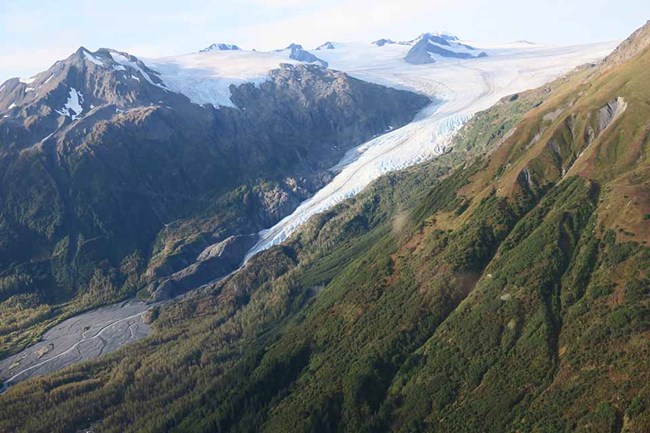Last updated: December 30, 2019
Article
Exit Glacier Floodplain Dynamics

Glacial conditioning of stream position and flooding in the braid plain of the Exit Glacier foreland, Alaska
Abstract
Flow spilling out of an active braid plain often signals the onset of channel migration or avulsion to previously occupied areas. In a recently deglaciated environment, distinguishing between shifts in active braid plain location, considered reversible by fluvial processes at short timescales, and more permanent glacier-conditioned changes in stream position can be critical to understanding flood hazards. Between 2009 and 2014, increased spilling from the Exit Creek braid plain in Kenai Fjords National Park, Alaska, repeatedly overtopped the only access road to the popular Exit Glacier visitor facilities and trails. To understand the likely cause of road flooding, we consider recent processes and the interplay between glacier and fluvial system dynamics since the maximum advance of the Little Ice Age, around 1815. Patterns of temperature and precipitation, the variables that drive high streamflow via snowmelt, glacier meltwater runoff, and rainfall, could not fully explain the timing of road floods. Comparison of high-resolution topographic data between 2008 and 2012 showed a strong pattern of braid plain aggradation along 3 km of glacier foreland, not unexpected at the base of mountainous glaciers and likely an impetus for channel migration. Historically, a dynamic zone follows the retreating glacier in which channel positions shift rapidly in response to changes in the glacier margin and fresh morainal deposits. This period of paraglacial adjustment lasts one to several decades at Exit Glacier. Subsequently, as moraine breaches consolidate and lock the channel into position, and as the stream regains the lower-elevation valley center, upper-elevation surfaces are abandoned as terraces inaccessible by fluvial processes for timescales of decades to centuries. Where not constrained by these terraces and moraines, the channel is free to migrate, which in this aggradational setting generates an alluvial fan at the breach of the final prominent moraine. The position of this fan is glacially conditioned but the process of migration of the braided channels across it is not. This broad perspective on channel controls identifies incipient avulsion into the roadside forest as part of a long-term fan-building process independent from changes in streamflow or sediment load.
Curran, J. H., M. G. Loso, and H. B. Williams. 2017. Glacial conditioning of stream position and flooding in the braid plain of Exit Glacier foreland, Alaska. Geomorphology 293(A):272-288.
